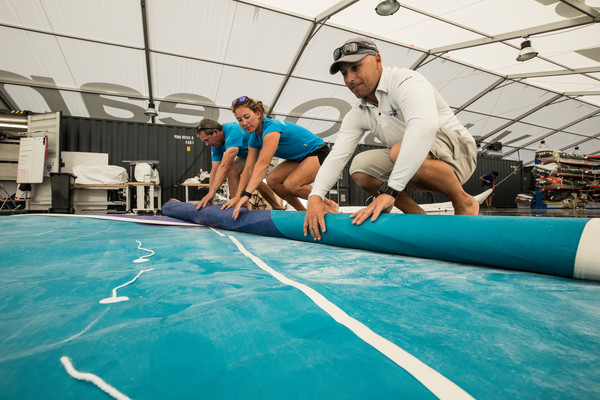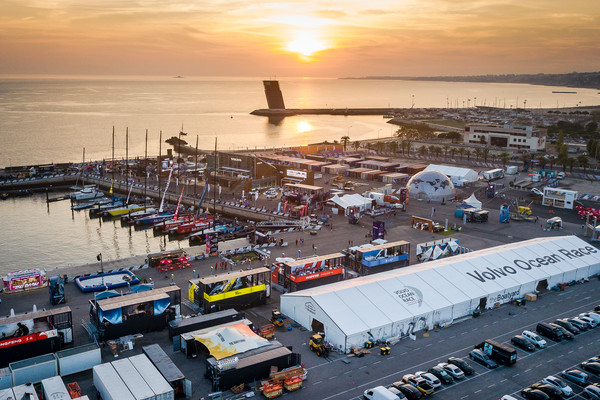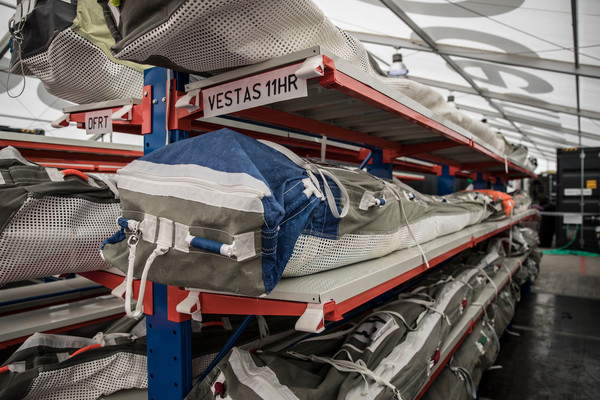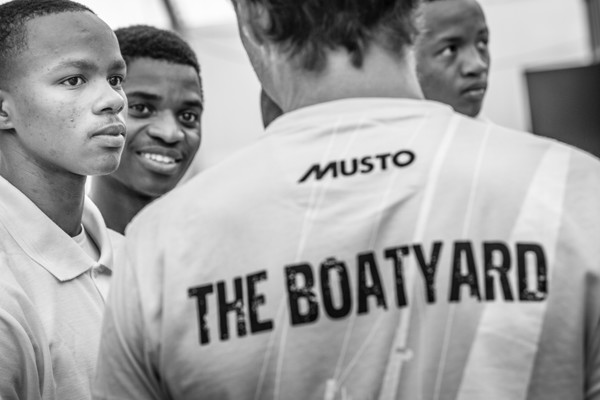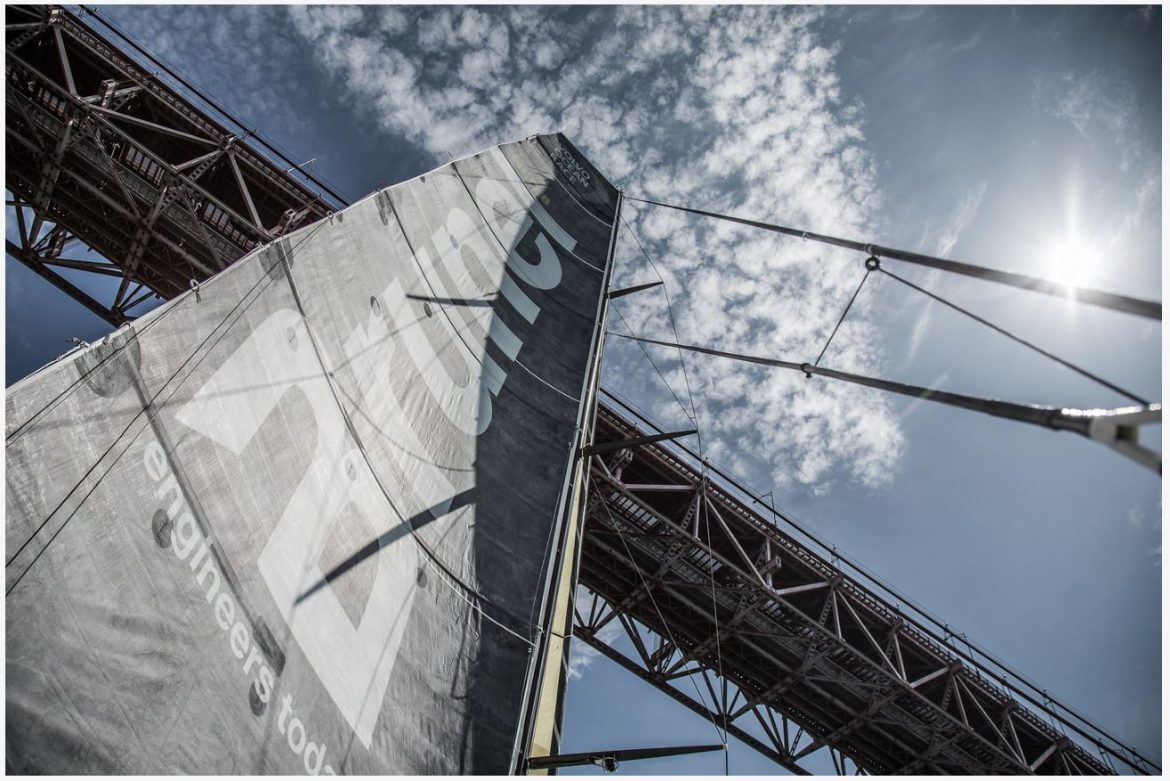Now that the teams in the Volvo Ocean Race are on their way to New Zealand and would have sailed 26400 miles on their arrival, it seems a good time to evaluate the sail inventory of the Volvo 65’s.
North Sails have powered eight of the nine Volvo Ocean Race winners since 1989. Here are 6 things you should know about the bespoke sails designed and manufactured for the Volvo Ocean Race and made using the advanced 3Di moulding technology in their Nevada facility.
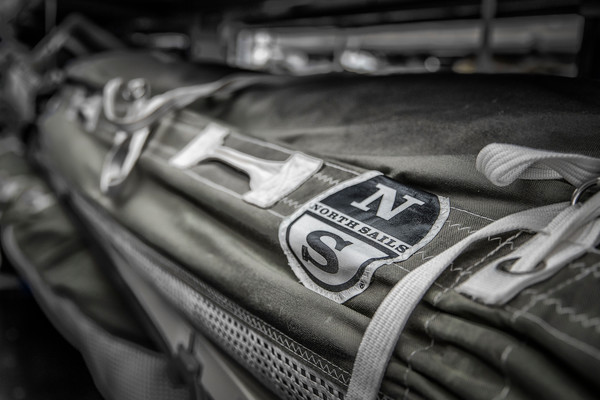
Boatyard in Cape Town. Photo by Ainhoa Sanchez/Volvo Ocean Race. 25 November, 2017
1. No cloth – all composite
Instead of assembling cloth panels into a particular sail shape, the Volvo Ocean Race sails are composites. This means that 3Di material ‘tapes’ are laid in a specific arrangement, offering stable structure to the sail where it is needed most. This provides an unmatched weight to stiffness ratio and advanced durability. This is a patented process at North Sails, so you won’t be able to get 3Di composites from anywhere else in the world.
 In 2014-15, each one-design Volvo Ocean 65 raced around the world with just 11 race sails + 1 Storm Jib, a major reduction in the inventory from previous races and a significant cost saving. Just eight race sails were allowed on board, with no (non-repair) recuts and only four replacement sails.
In 2014-15, each one-design Volvo Ocean 65 raced around the world with just 11 race sails + 1 Storm Jib, a major reduction in the inventory from previous races and a significant cost saving. Just eight race sails were allowed on board, with no (non-repair) recuts and only four replacement sails.
The 2017-18 edition of the race uses an updated inventory which includes a new dedicated light air upwind sail – J0, and except for the storm jib, all sails are built to varying deniers under North Sails’ 3Di process, using pre-impregnated tapes made of yellow Twaron Aramid and white Dyneema SK75 fibres. (RAW760 Yellow). Teams are now allowed to purchase two of every sail code for the race plus an additional 6 sails for training prior to race start. Only 2 x mainsails can be purchased.
2. One-design at its best.
The process of producing the raw sail shape is now fully automated and several quality control steps are taken along the way to ensure consistency. In the past, manually joining panels to produce a sail meant no two sails were ever identical. North Sails 3Di has solved this problem and is the only option for a One Design race at this level
No carbon is allowed in the sail material as it could interfere with the signals to and from the satellites essential for communication and data transfer. Production and delivery is carefully controlled. Race sails are also built in batches so that the same mould is used to produce eight sails of one type. Each sail type is then finished in the same loft by the same team consecutively to ensure an identical shape and production quality.
3. The Sail Inventory:
Each Volvo Ocean Race team receives a full sail inventory, which assembles like a jigsaw puzzle to create a package. While the sails across the fleet are all identical, the difference lies in how they’re used – with slight variations of angle, trim and tuning. Each team will push their boat, rig and sails slightly differently, inching out every bit of performance.
Total number of sails for the race: 16 + 1
Total number of sails on board: 8 + 1 storm jib
Upwind sail area: 467 m2 (mainsail and masthead Code 0) / 333 m2 (mainsail and biggest jib J0)
Downwind sail area: 537 m2 (mainsail and A3 gennaker)
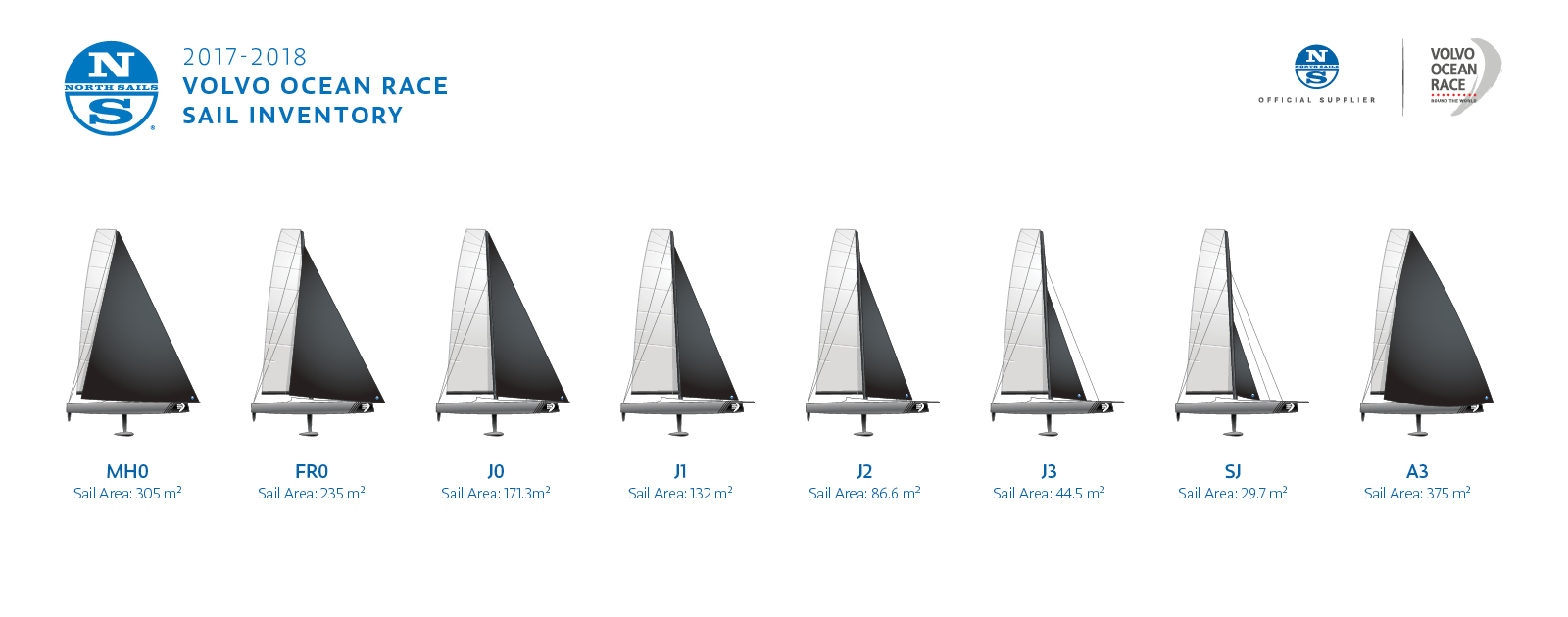
1 x Mainsail
Sail area: 161.8 m²
Material: 3Di, RAW760 yellow, 27000 dpi
Details: 3 reefing points, 6 battens
Use: At all times
1 x J0
Sail area: 171.3m²
Material: 3Di, RAW760 yellow, 22400 dpi
Details: Masthead sail set on bowsprit and sheeted to jib sheet lead or forward outrigger position.
Use: The J0 will be primarily used upwind in light to moderate winds (6-13 knots), and tight reaching.
1 x J1
Sail area: 132 m²
Material: 3Di, RAW760 yellow, 23800 dpi
Details: Installed on a fixed forestay with hanks. Horizontal battens including 2 full head ones.
Use: The J1 will be used upwind in light to moderate winds (8-15 knots), and when reaching.
1 x J2
Sail area: 86.6 m²
Material: 3Di, RAW760 yellow, 32000 dpi
Details: Deployed with a roller furler with vertical leech battens.
Use: Good for 13-25 knots. The J2 will be used upwind in fresh breeze and downwind inside the MHO or the A3 as a staysail – it can even be used downwind in strong wind. Unlike the Volvo Open 70’s J2, this one is furled and for that reason, utilises a halyard lock.
1 x J3
Sail area: 44.5 m²
Material: 3Di, RAW760 yellow, 32000 dpi
Details: Deployed with a roller furler.
Use: Good for 22-35 knots. Similar use than the J2 in stronger breeze. The teams will have to make the call whether the J2 or the J3 is more efficient as a staysail inside the A3 and MHO – they may even use them together! The J3 will be used inside the J1 and FR0 – it’s the genoa staysail. The J2 is too big for this application – it’s the spinnaker staysail.
1 x A3 (Gennaker)
Sail area: 375 m²
Material: 3Di, RAW760 yellow, 7650 Dpi
Details: Deployed with a roller furler.
Use: The A3 is the only dedicated downwind sail used to sail broad angles, typically used at true wind angles of 120° and above. It is similar to the one used on a Volvo Open 70.
1 x Fractional Code 0 (“FRO”)
Sail area: 235 m²,
Material: 3Di, RAW760 yellow, 16800 dpi
Details: Hoisted to the hounds.
Use: The FRO is a downwind sail used in fresh breeze (when the A3 becomes too big) and for reaching (when the MHO is too big). It will likely be used upwind in light breeze too.
1 x Masthead Code 0 (“MHO”)
Sail area: 305 m²
Material: 3Di, RAW760 yellow, 13600 dpi
Details: —
Use: The MHO is a light wind sail (0-6 knots). It is also used when reaching in moderate conditions and downwind in strong breeze.
1 x Storm Jib
Sail area: 29.7 m²
Material: panelled spectra S395
Details: —
Use: Good for 35 knots+. Only storm jib available for the entire race.
An outrigger will extend 1.5m outside the hull either mid ships for the jibs or aft near the stern for the MH0, FR0 and A3.
4. Optimised sail changes
Each Volvo Ocean Race team also receives a bespoke Velocity Prediction Program, illustrating the potential performance of their boat according to inputs such as true wind speed and angle, and advises the proper sail to be used to optimise racing performance in each condition.
The teams were forever changing configurations in 10-15 knots upwind and tight reaching. When using the masthead zero the teams were pushing the boat too hard. Changing to the J1 made them under powered. So, one of the changes we made for 2017 was to add a J0, which fits between the MHO and J1 and covers that range.

Hong Kong Stopover. Around Hong Kong Island Race. 28 January, 2018.
5. Doing the sail shuffle
The introduction of a J0 to the sail inventory has led to some other key changes in the range. For example, the Fractional Code Zero, or FR0, which was previously used in a very small upwind range between the J1 and masthead zero, is now a dedicated downwind sail. The FRO for the 2017-18 edition is made of 3Di FORCE, a new downwind application of North Sails 3Di composite sailmaking. This means that the sail is more stable with a 3Di structure throughout an increased range of conditions, which is great news for both sailors and designers. The bonus of 3Di is that the sails are more easily repeated, as moulded sails offer more streamlined manufacturing and assembly than panelled ones. Each type of sail can be made in sequence: the mold is set once and the sails are consolidated one by one, which is key in a One Design class.
 6. Sail support
6. Sail support
There’s not much tougher test for a sail than the Volvo Ocean Race, and that’s why there’s a dedicated Boatyard team featuring a host of expert riggers, builders and sailmakers travelling to every Host City and working around the clock to keep the boats in good shape. They check between 60-80 sails every stopover, so reliability is key – and with 90% of all damage to sails happening during manoeuvres and sail changes, subtle changes to the finishing of the sails to improve handling has been a game changer. To cut the time and energy used onboard, the luff length on the code sails has been reduced to allow for easier sail “peels” or changes, and, additionally, a relatively simple fitting – called an ‘integrator’ – has been added to the A3 (the biggest sail on board). This enables top-down furling which is preferred over bottom-up for larger running sails due to a faster, neater result and less chance of damage.

Hong Kong Stopover. The Boatyard working just after the boats arrived in Hong Kong. 21 January, 2018.
There is no crystal ball when it comes to predicting a race around the planet, but sail designers can study the race route and draw decision making data from historical weather patterns.
With the addition of one more sail, the crew are often quick to point out that it’s one more sail to handle, one more sail to stack. But after looking at the inventory and assessing the available configurations, we found that the amount of sail changes reduces significantly with the addition of the J0
With slight variations of angle, trim and tuning; each team will push their boat, rig and sails slightly differently, inching out every bit of performance. While the sails across the fleet are all identical, the difference lies in how they’re used.

